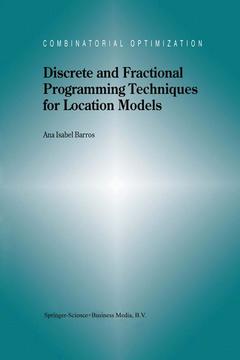Discrete and Fractional Programming Techniques for Location Models, 1998 Combinatorial Optimization Series, Vol. 3
Langue : Anglais

At first sight discrete and fractional programming techniques appear to be two com pletely unrelated fields in operations research. We will show how techniques in both fields can be applied separately and in a combined form to particular models in location analysis. Location analysis deals with the problem of deciding where to locate facilities, con sidering the clients to be served, in such a way that a certain criterion is optimized. The term "facilities" immediately suggests factories, warehouses, schools, etc. , while the term "clients" refers to depots, retail units, students, etc. Three basic classes can be identified in location analysis: continuous location, network location and dis crete location. The differences between these fields arise from the structure of the set of possible locations for the facilities. Hence, locating facilities in the plane or in another continuous space corresponds to a continuous location model while finding optimal facility locations on the edges or vertices of a network corresponds to a net work location model. Finally, if the possible set of locations is a finite set of points we have a discrete location model. Each of these fields has been actively studied, arousing intense discussion on the advantages and disadvantages of each of them. The usual requirement that every point in the plane or on the network must be a candidate location point, is one of the mostly used arguments "against" continuous and network location models.
1. Introduction. 2. Discrete Location Models. 3. Location Models and Fractional Programming. 4. Generalized Fractional Programming. 5. Summary and Remarks. Index.
This book is a revised and updated version of the INFORMS award winner for `best dissertation on Location Analysis of 1995'. The book integrates two seemingly unrelated fields: location analysis and fractional programming. Location analysis deals with the problem of where to locate facilities in such a way as to optimize a particular criterion taking into account the existing clients. Fractional programming is a special field of nonlinear programming dealing with optimization problems where the objective function consists of a ratio of given functions. Although the application scope of fractional programming is vast, it has not been much related to specific operations-research problems, and in particular, to location analysis. This book manages to bridge this gap by tackling several locati
Date de parution : 11-2013
Ouvrage de 180 p.
15.5x23.5 cm
Disponible chez l'éditeur (délai d'approvisionnement : 15 jours).
Prix indicatif 52,74 €
Ajouter au panierThèmes de Discrete and Fractional Programming Techniques for... :
© 2024 LAVOISIER S.A.S.


